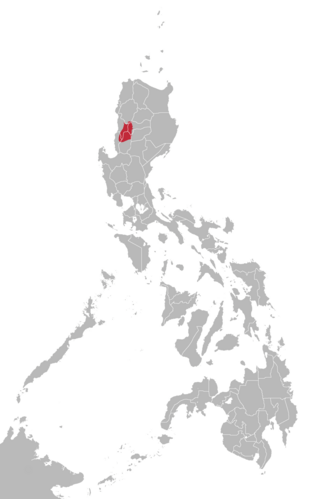
The Cordillera Administrative Region, also known as the Cordillera Region and Cordillera, is an administrative region in the Philippines, situated within the island of Luzon. It is the only landlocked region in the archipelago, bordered by the Ilocos Region to the west and southwest, and by the Cagayan Valley Region to the north, east, and southeast.

The indigenous peoples of the Cordillera in northern Luzon, Philippines, often referred to by the exonym Igorot people, or more recently, as the Cordilleran peoples, are an ethnic group composed of nine main ethnolinguistic groups whose domains are in the Cordillera Mountain Range, altogether numbering about 1.8 million people in the early 21st century.

Kankanaey is a South-Central Cordilleran language under the Austronesian family spoken on the island of Luzon in the Philippines primarily by the Kankanaey people. Alternate names for the language include Central Kankanaey, Kankanai, and Kankanay. It is widely used by Cordillerans, alongside Ilocano, specifically people from Mountain Province and people from the northern part of the Benguet Province. Kankanaey has a slight mutual intelligibility with the Ilocano language.

Boliney, officially the Municipality of Boliney, is a 5th class municipality in the province of Abra, Philippines. According to the 2020 census, it has a population of 4,551 people.

Tubo, officially the Municipality of Tubo, is a 4th class municipality in the province of Abra, Philippines. According to the 2020 census, it has a population of 5,674 people.

Kalinga is a dialect continuum of Kalinga Province in the Philippines, spoken by the Kalinga people, alongside Ilocano. The Banao Itneg variety is not one of the neighboring Itneg languages.

Ifugao or Batad is a Malayo-Polynesian language spoken in the northern valleys of Ifugao, Philippines. It is a member of the Northern Luzon subfamily and is closely related to the Bontoc and Kankanaey languages. It is a dialect continuum, and its four main varieties—such as Tuwali—are sometimes considered separate languages.

Bontoc (Bontok) is the native language of the indigenous Bontoc people of the Mountain Province, in the northern part of the Philippines.

Pashayi or Pashai is a group of Indo-Aryan languages spoken by the Pashai people in parts of Kapisa, Laghman, Nangarhar, Nuristan, Kunar and Kabul provinces in Northeastern Afghanistan.

Isnag is a language spoken by around 50, 101 Isnag people of Apayao Province in the Cordillera Administrative Region in the northern Philippines and they are also found in parts of Cagayan, and Ilocos Norte. Their populations are distributed across the municipalities of Calanasan, Kabugao, Pudtol, Flora, Luna, Santa Marcela, and Conner in Apayao; the eastern part of Ilocos Norte, specifically Adams, Carasi, Dumalneg, Vintar, Marcos, Dingras, Solsona, Bangui and Pagudpud; the northwestern part of Cagayan, particularly Santa Praxedes, Claveria, Sanchez Mira, and Pamplona; and the northern part of Abra, particularly Tineg. Around 85% of Isnag are capable of reading the Isnag language. Many Isnag speakers also speak Ilocano.
The Bolinao language or Binubolinao is a Central Luzon language spoken primarily in the municipalities of Bolinao and Anda, Pangasinan in the Philippines. It has approximately 50,000 speakers, making it the second most widely spoken Sambalic language. Most Bolinao speakers can speak Pangasinan and/or Ilocano. Ethnologue reports 510 monolinguals for this language.
Abellen, Abenlen, Aburlin, or Ayta Abellen, is a Sambalic language. It has about 3,500 speakers and is spoken in a few Aeta communities in Tarlac province, Philippines. Ayta Abellen itself is part of the Sambalic language family in the Philippines and is closely related to not only the five other Ayta dialects but also the Botolan dialect of Sambal. Ethnologue reports 45 monolinguists.
The Meso-Cordilleran languages are a group of languages spoken in or near the Cordillera Central mountain range in Northern Luzon. Its speakers are culturally very diverse, and include the lowland Pangasinense, the Igorot highlanders, and Alta-speaking Aeta groups.

Gaʼdang is an Austronesian dialect spoken in Northern Luzon, Philippines particularly in Paracelis, Mountain Province, Luzon; Potia, Ifugao Province; and Tabuk, Kalinga Province. There are some residents of speakers in Aurora and Nueva Vizcaya. Many Ga'dang speakers speak Ilocano as their second language.
Calamian Tagbanwa is spoken in the Calamian Islands just north of Palawan Island, Philippines. It is not mutually intelligible with the other languages of the Tagbanwa people. Ethnologue reports that it is spoken in Busuanga, Coron, Culion, and Linapacan municipalities.

Idalaka is a Malayo-Polynesian dialect chain spoken in East Timor. The name is a portmanteau of Idaté and Lakalai.

Iwaak is a South-Central Cordilleran language spoken by almost 3,300 people around the Cordillera Central mountain range of Luzon, Philippines. It is a Pangasinic language which makes it closely related to Pangasinan, one of the regional languages in the country, with around 1.2 million speakers.

Isinai is a Northern Luzon language primarily spoken in Nueva Vizcaya province in the northern Philippines. By linguistic classification, it is more divergent from other Central Cordilleran languages, such as Kalinga, Itneg or Ifugao and Kankanaey.

The Northern Luzon languages are one of the few established large groups within Philippine languages. These are mostly located in and around the Cordillera Central of northern Luzon in the Philippines. Among its major languages are Ilocano, Pangasinan and Ibanag.
The Central Cordilleran languages are a group of closely related languages within the Northern Luzon subgroup of the Austronesian language family. They are spoken in the interior highlands of Northern Luzon in the Cordillera Central mountain range.















